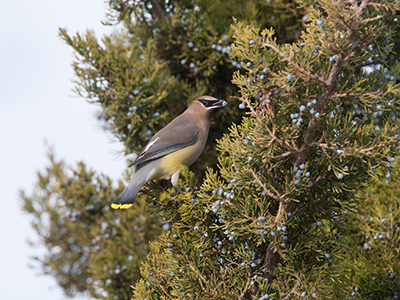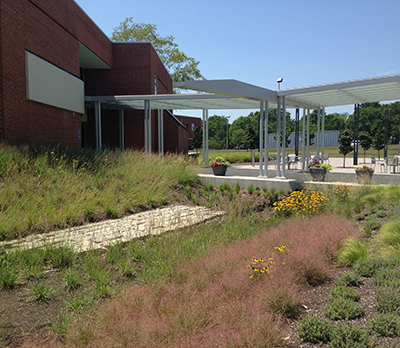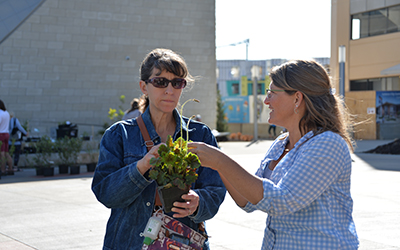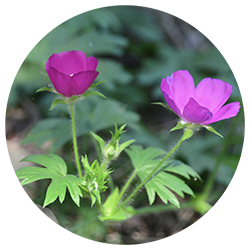Get Started
Starting with native plants can be as easy as picking out a great spot for an oak tree in your yard or adding to an existing flower bed. First, observe the conditions in your space for several days. Note how much sun the site gets, and how quickly it dries after a rain. Prepared with this information, you’ll be ready to select your plants.
Sun and Shade Definitions for Gardening
Tips on Measuring Soil Moisture (Note this link contains some advice on how to garden with dry or moist soil – wise native plant choice eliminates the need for these measures)
What to Know About Starting Your First Native Plant Garden
How to Bring Native Plants Into an Established Garden
Soil Preparation and Testing
To prepare a new garden from a patch of lawn, you can either remove the sod with a shovel or sod cutter, or you can use recycled material to smother the existing vegetation as explained in the link below.
Garden Prep: How to make a bed with cardboard
Generally speaking, you will not need to fertilize or add additional nutrients to a native garden. If you feel your soil is in need of a checkup, the resources below can help you test your soil.
Choose Your Plants
Once you know your site conditions, it’s time to start researching your plants. Successful gardening is all about putting the right plant in the right place. Try one of these databases to find great native species that will love your yard. Give consideration to when each will bloom. Selecting varieties of plants with staggered bloom times will give consistent nectar for pollinators and keep the garden interesting from spring through winter.
Lady Bird Johnson Wildflower Center Database
Audubon Native Plants Database
National Wildlife Federation Native Plant Finder
If you prefer the simplicity of starting from a list, check out these resources:
Top Plants for Native Bees in KC Area
Book Suggestions for Plant Selection Tips:
Native Plants of the Midwest by Alan Branhagen


Consider Trees and Shrubs
Experienced gardeners know that careful selection and placement of trees and shrubs will bring structure and interest to any planting. Native trees and shrubs provide edible leaves, nectar, fruit, and seeds, bringing tremendous wildlife value to your property. At the same time, they provide economic benefit: increasing your property value and decreasing your utility costs.
Missouri Department of Conservation Guide to Tree Planting & Care
Buffalo grass is a fantastic no-mow lawn replacement species, but is difficult to get and keep established in the Kansas City area, due to our plentiful rain and rich soils. Gardeners with dry, full-sun yards and lots of persistence to keep the weed competition down will have better, though still limited, success.
Sedge lawn replacements are generally more successful in the Kansas City area, but be sure to choose an appropriate sedge for your yard’s moisture and sun levels.
Meet a Lawn Alternative That Works Wonders
Native Sedges Fit for Gardening
Link to Case Study (coming soon)
If half of American lawns were replaced with native plants, we would create the equivalent of a 20 million acre national park, nine times bigger than Yellowstone, or 100 times bigger than Shenandoah National Park.
— Doug Tallamy



Design Your Garden
A classic beginner’s design mistake (we’ve made it too!) is to buy one each of a dozen types of plants and mix them all together in the bed. The results still attract the birds and bees that we love, but the neighbors may not quite see the value. An attractive native plant garden serves as ambassador to the neighborhood as well as a refuge for wildlife and people.
Go It Alone
There’s no better way to learn than by diving right in! A little time spent reading up on garden design principles will help you begin to think about your layout. Consider these basic rules of thumb and check out our suggested resources to get you started:
Plant in groupings of the same plant – this avoids the “polka dot” garden look, and is better for pollinators who can more easily spot them from the air.
Choose odd numbered groupings – one or three will generally look better to the eye than two or four.
Consider overall height of mature plants and use taller species toward the back.
Utilize sedges and native groundcovers between flowers to mimic natural plant communities and decrease maintenance – check out Planting in a Post-Wild World for more on this approach.
How to Design a Native Plant Garden
Book Suggestions for Design Advice:
Planting In a Post-Wild World by Claudia West and Thomas Ranier
The Living Landscape: Designing for Beauty and Biodiversity in the Home Garden by Rick Darke
The Know Maintenance Perennial Garden by Roy Diblik
Use a Template
Beginning with a design template is a convenient way to get started. Bear in mind that because no two sites are alike, you’ll likely make adjustments over time.
Dyck Arboretum Landscape Plans
WildOnes Native Landscape Plans
Hire a Professional
Are you design challenged? Short on time? Have a difficult space? Just need some one-on-one guidance? Hire some help for design, installation, management, or all of the above. The collection of KC area professionals specializing in native plantings is small but mighty – and growing!

Buy Your Plants
This list is just a sample of the native plant availability in our region, and we’ve probably missed a few gems. Would you like to recommend a garden center or nursery with great native plants? Let us know so our list can grow!
When buying plants or seeds from a new source, it’s a good idea to ask questions about: where seeds were collected (closer is better), whether plants are cultivars or true native species (what’s the difference and why does it matter?), and whether any pesticides have been used.Native Plant Sales
Each spring, we compile a list of native plant sales being held in the area. If Saturday mornings aren’t for you, you can find other options below.
Native Plant Nurseries in the KC Metro
The following nurseries grow and sell native plants, and you can be assured you are getting true native species (also called “open pollinated” or “straight species”) that are safe and healthy for your garden and its inhabitants. Find hours, locations, and farmer’s market dates at the websites below.
Prairie & Wetland Center (CritSite)

Mail Order Native Plants
If you can’t get out to the plant sales or nurseries, native plants can come to you. Check out these options for convenience.
Tree Seedlings – Missouri Dept. of Conservation
Tree Seedlings – Kansas Forest Service
Check Your Local Garden Center
Many garden centers sell native plants, either in a separate section or mingled with non-native perennials. The centers below have confirmed availability of native plants in the KC metro. If your local garden center doesn’t carry native plants yet – ask them to do so!
Find others (around KC and regionally): Grow Native Professional Member Nurseries
Wholesale Native Plants for Professionals and Big Projects
Professional landscapers, designers, and others in need of frequent or large quantities should check out the wholesalers below.
Seed Sources
Be sure to research any seed purchases carefully – local ecotype seeds will generally be most successful and beneficial. Often non-native or even invasive species are included in seed blends – this is especially likely in “wildflower” mix seed packets but sometimes in bulk “native” mixes too. Don’t be afraid to ask questions and do your homework. For more on how to convert large areas, see our resources on Large Scale Planting Advice.
Managing Your Planting
Unfortunately, there is no such thing as a “no maintenance” garden. In general, the better your site preparation, plant selection, and design is, the easier your maintenance will be. We like to think of gardening as a conversation: As the plants ebb and flow throughout the seasons, responding to insects, weather, and each other, the gardener and the garden engage in a dialogue. You may try a plant in a certain spot only to find it will not survive there, and next year try another. Experiment with methods and timing of maintenance tasks to find out what works best in your space. Make notes for next year and enjoy the learning process!
Watering
In general, native plants need to be watered only until they become established, depending on the root development of your plants and the weather, this may be during the first few weeks up to the first year or so. Water young trees and shrubs deeply for the first three to five years, and other plants when the top inches of soil become dry.
Water Smart Guide from Dyck Arboretum

Weeding
Removing weeds and volunteer trees is a necessary task in any garden. You can decrease the need for weeding by planting closer together, utilizing sedges or native ground covers between plants, and deadheading too-enthusiastic re-seeders after they bloom. Sometimes weeds are difficult to distinguish from your native plant seedlings. When in doubt, you can wait a few weeks before deciding whether to pull a mystery plant.
Mulching
While you may wish to mulch a new bed after planting to help keep weeds down and moisture up, regular applications of heavy mulch will not do your native garden any favors. Look to nature to help you decide if and when to mulch. Prairie species will not respond well to heavy wood mulch, while woodland species will appreciate a generous layer of fall leaves.
You should mulch under new trees and shrubs to help keep moisture in, but avoid the dreaded mulch volcano!
Cutting Back
Tall plants that bloom late in the season, such as asters and goldenrods, may benefit aesthetically from an early summer cut back, removing one-third to one-half the plants’ height. This optional task can be repeated later in the year if needed, but avoid doing it too close to flowering time so the plant can bloom.

Deadheading
Another optional technique, deadheading is the process of removing a flower once the bloom has faded, to avoid letting the plant go to seed. Because native flowers’ seeds are a food source for many birds, consider your priorities here. You may prioritize wildlife value, or decreased re-seeding, or maybe land somewhere in the middle, removing some but not all spent flowers.
Garden Cleanup
Many native plants have great winter structure and interest. Many also play an essential role in pollinator winter survival. Native bees and other beneficial insects use standing plant stems to lay eggs, which are protected over the winter to emerge in the spring. Skip the fall cleanup and leave your plants standing until early spring for the most vibrant assortment of bees and pollinators next year!
Likewise, many species of butterflies, moths, and bees survive the winter hidden in the fallen leaves. Don’t throw out the garden guests you’ve worked to provide for all year – leave at least a portion of your fallen leaves to shelter wildlife until spring. You can add them as mulch to shady beds, spread under shrubs or hide a leaf pile near the back of your property, or simply leave them where they lay and catch up on football or family time instead of raking.
Pruning trees and shrubs
Pruning is done for tree health, stability, appearance, and/or fruit production. If you’ve planted some shrubs for the birds or a woodland for wildlife, pruning probably doesn’t make sense. If you’ve planted a shade tree near your house, pruning should be on your radar to decrease the potential for storm damage.
MU Extension Guide to Pruning Trees & Shrubs– not all native but good general advice
Collecting Seeds
As your garden matures, you may wish to begin collecting seeds to expand your plantings, or to share with friends and family.
Large Scale Planting Advice
We are still constructing this section. Check for upcoming large landscape workshops on our Events page, and make sure to let us know if you have great links to share!
Seeding Wildflowers and Native Grasses
How to Grow a Prairie From Seed
Fire In the Park – Why We Burn
For large scale restoration efforts, you may want to employ the help of a contractor for site preparation, planting, and/or maintenance.

Native Plants for Containers
No yard to plant? Some native plants do very well in containers for a balcony or patio. You can plant in pots of single species, or mix and match the elements of a container garden:
Thrillers (tall upright eye-catching plants)
Spillers (those that spill over the edges of the container)
Fillers (something to spread out and fill in the gaps)
Remember to make a note of the available light in your space and select your plants accordingly. In general, plants with very deep roots will not grow well in containers, though there are some exceptions that will still thrive.
GrowNative! Plant Picker Database– Select “Container” under special use.
Invasive Species
Regardless of the size of your planting – watch out for these horrible, terrible, no good, very bad plants! Do not buy or plant them, and act quickly to remove invasive plants when they show up in your space.
Invasive Plant ID and Control Resources for Kansas
Places to Visit
Over and over, studies show that time spent with nature helps us decompress, lowers our stress levels, makes us happier and healthier. Venture out to get a Vitamin N boost, and maybe even a little inspiration for your next native planting. Remember to practice Leave No Trace ethics and preserve these special places for all of us to enjoy, now and far into the future.
Tallgrass Prairie National Preserve
Johnson County Park & Recreation District Trails


